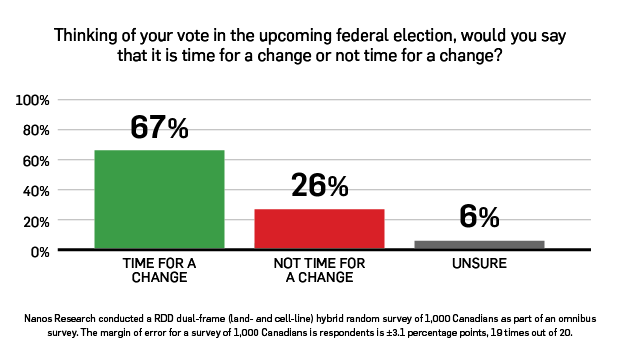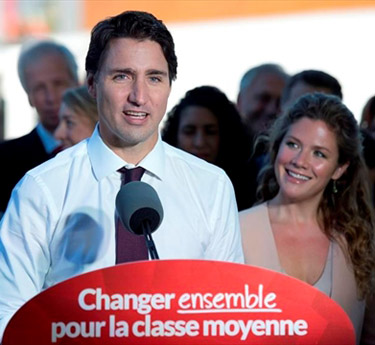How many red sails in the sunset .. should we start getting ready for another PM Trudeau ??
Oct 10th, 2015 | By Counterweights Editors | Category: In Brief

Toronto-born UBC graduate Anna Wallner (l) and Sophie Gregoire Trudeau, back before Justin became Liberal leader and all that. But always ready to rock ‘n roll?
Here in Toronto, where our editorial offices are currently located (most of the time), with just nine days before the fateful 2015 Canadian federal election on October 19, we are starting to learn that you have to be steely about the baseball Blue Jays.
Meanwhile, back in the land of election data, if there is some increasingly visible degree of  progressive vote consolidation with one of the two main parties anywhere, it is here. As in : “Liberals poised to take back seats in Toronto … If recent polls are accurate, the Liberals look to make sizable gains in and around Toronto. That’s bad news for the NDP, experts say.”
We’re among those who don’t quite understand why it is necessary  for the likes of New Democrat Olivia Chow and Liberal Adam Vaughan to waste time and money running against each other. It was encouraging to hear that the older and wiser NDP luminary Gerry Caplan had some harsh words on CBC TV yesterday, for Liberals and New Democrats who attack each other instead of the Conservatives!
At the same time, this past Thursday was also the first day in a while that Eric Grenier’s CBC Poll Tracker averages have projected the Liberals with the largest number of seats, across Canada. (The subsequent Friday results – Â “Updated October 9, 2015, including polling in the field to October 8, 2015” – show Liberals 132 seats, 33.8% Canada-wide vote ; Conservatives 123 seats, 32.4% ; New Democrats 80 seats, 23.6%. And today’s Saturday results –“Updated October 10, 2015, including polling in the field to October 9, 2015” – show the same big picture : Liberals 131 seats, 33.6% Canada-wide vote ; Conservatives 122 seats, 31.8% ; New Democrats 80 seats, 23.8%. Grenier assigns the one seat each that both Liberals and Conservatives have “lost” since yesterday to the Bloc Quebecois!)
As prominent and enduring as it may or may not prove to be, this very latest and still suitably modest red sail in the approaching political sunset is certainly not finally confined to the telephone area code 416 definition of Toronto (aka The Six, thanks to Drake) – or even the wider 905 Greater Toronto Area.
On Mr. Grenier’s current calculations the federal Liberals, like both their Conservative and NDP rivals, will take seats in every province. And – on this evidence at any rate – they are especially strong (or stronger than they used to be) in Atlantic Canada and Ontario, and on  Canada’s Pacific coast in beautiful BC.
(Although the relative intensity declines as you move west. There is a kind of  eastern + BC and northern territorial tilt to both the Liberal and NDP voting blocs that Mr. Grenier’s polling averages currently envision – and a western + Ontario tilt to the Harper Conservatives.)
It can’t seriously be said that there is anything particularly “Toronto-centred” about all this. The Liberals are strongest in Atlantic Canada right now. Â Justin Trudeau’s deepest urban roots are in Montreal and Vancouver.
It has nonetheless felt like red sails of some sort have been setting over the old fur trade outpost on the northwest shore of Lake Ontario lately,  along with various other parts of the country. Rick Salutin’s column in the Toronto Star yesterday – “How Justin became Mr. Trudeau: Salutin … Justin Trudeau has withstood a pummelling that wasted  the two previous Liberal leaders so badly that each broke down publicly” – helps explain something of this particular red Canadian mood, in the country’s current largest metropolis.
In its wider cross-Canada expression this mood may finally lead Justin Trudeau back  to the prime minister’s residence at 24 Sussex in Ottawa – scene of no doubt many adventures of his early life, from birth to 12 years old. If this does happen, Jeb Bush and Hillary Clinton will have nothing to teach Canadians about family political dynasties in democratic countries. But maybe all we really serious democrats will be happy enough anyway. Since early in 2006 we have known what it means to say “things could be worse” than another Prime Minister Trudeau  …
* * * *
Whatever else, the numbers that we  have right now are still  far from dead certain. Consider these four options :
1. Â Second Conservative majority government ????
At one extreme there are still those who believe a second Conservative majority in the Canadian House of Commons remains a possibility. It was only a week ago that Don Martin was writing about how “If voters want to give Stephen Harper an historic fourth mandate and second majority, they’re absolutely right to do so … Just don’t do it for the wrong reasons.”
As of right now, a week later, we don’t quite see the numbers for this ourselves. Consider, eg, parallel Nanos Nightly Tracking results for 12 and 11 days before the election now in 2015, and then in the last federal election of 2011, when the Harper Conservatives finally did win a majority of seats in the elected house of parliament :
Nanos Nightly Tracking for April 20, 2011, 12 days before … 39.0% for the Conservatives, 26.7% for the Liberals, 22.1% for the NDP, and 3.4% for the Greens nationally.
Nanos Nightly Tracking for October 7, 2015, 12 days before … 33.5% for the Liberals, 31.6% for the Conservatives, 24.2% for the NDP, and 4.6% for the Greens nationally.
Nanos Nightly Tracking for April 21, 2011, 11 days before … 37.8% for the Conservatives, 26.1% for the Liberals, 23.7% for the NDP, and 3.5% for the Greens nationally.
Nanos Nightly Tracking for October 8, 2015, 11 days before … 34.0% for the Liberals, 31.0% for the Conservatives, 25.0% for the NDP, and 4.2% for the Greens nationally.
You can say this is just Nanos polling. Others are different. And three of the last 10 polls consulted by Eric Grenier’s CBC Poll Tracker do show the Conservatives somewhat ahead of the Liberals. But even these are not showing Conservative numbers as high as Nanos was reporting at this point in the 2011 campaign. And seven of the last 10 (and four of the last five) polls here show the Liberals ahead.
Of course in politics crazy surprises are always possible – as in the case of the bare majority government the UK Conservatives finally came up with this past spring, with less than 37% of the cross-UK popular vote! And see Robert Fisher on “2015 election has parallels to 1999 Ontario vote” (in which the Mike Harris Conservatives did win a second majority government).
2. Â Conservative minority government ????
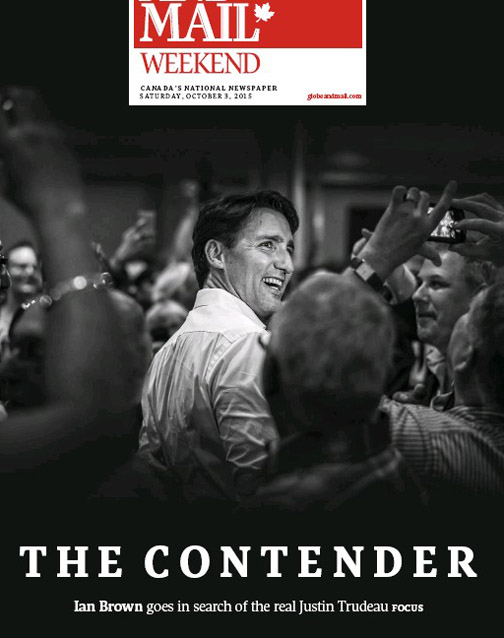 This seems much more of a possibility. In fact, until the day before yesterday, it was the option Grenier’s CBC Poll Tracker had been projecting for some time most recently.
This seems much more of a possibility. In fact, until the day before yesterday, it was the option Grenier’s CBC Poll Tracker had been projecting for some time most recently.
And see also : “Stephen Harper unpopular — except with those who worship him” from the Globe and Mail and “My election prediction: Conservative minority government” from the Hill Times.
Ever since both Trudeau and Mulcair have spelled out their unwillingness to support a Conservative minority government this time around, the fate of any such thing has seemed to be short-lived at best.
At the same time, the prospects here have begun to be aired in the media. See, eg : “What the Liberals, NDP are thinking if Harper wins a minority … JANE TABER” ; “Election 2015: What happens if none of the parties wins a majority? … Assumption that party who wins the most seats automatically becomes minority government isn’t true” ; “Would Harper serve as Opposition leader? ‘We’ll cross that bridge when we come to it …We believe that whoever wins the most seats forms the government’”; Â and “TOM FLANAGAN … The campaign’s final make-or-break weeks … If … the Conservatives can win a strong plurality, say 150 seats against 100 for the Liberals, they might have a chance to survive” !!!!
What all this suggests to us is that any easy assumptions about how short-lived a Conservative minority government might be are untested at best. A lot probably does depend on the exact numbers involved. And we can guess that Mr.Harper will try to exploit whatever advantages having the largest number of seats might offer with great determination and narrow passion (and not too much thought for such wet concepts as the greater good of Canada and the Canadian people).
Just from the standpoint of stable government, apart from anything else, all this leads to the belief that for those of us who’d like to see more progressive Canadian values at work in Ottawa over the next four years, the best option right now is :
3. Â Liberal minority government supported by New Democrats ????
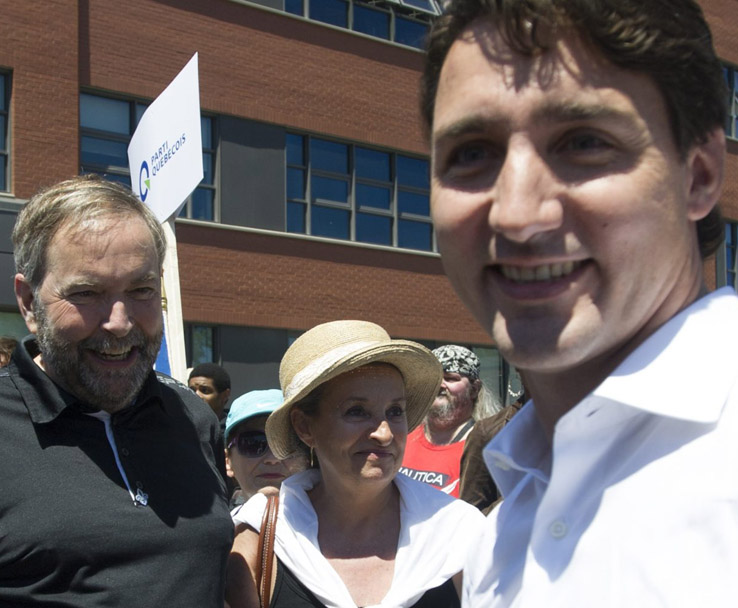
If that’s how things do work out on October 19, will Mr. Mulcair and Mr. Trudeau really be able to get along well enough for some new co-operative progressive government in Ottawa?
We’d be just as happy ourselves with an NDP minority government supported by Liberals. No polls at the moment, however, are holding out any prospect of that!
Things might change between now and a week this coming Monday (aka Canadian Thanksgiving Day). And if we were working on the NDP campaign we’d be assuming New Democrats will ultimately win the largest number of seats. But, if the polling means anything, Â there’s not much time for the numbers to change as much as they would have to for this.
Meanwhile, a Liberal minority government is what Eric Grenier’s Poll Tracker is  projecting right now – 132 seats in Ottawa for the Trudeau Liberals, 123 for the Harper Conservatives, 80 for the Mulcair New Democrats, 2 for the Bloc Quebecois, and 1 for the Greens. (Or as of later this afternoon, to be a little more exact and up-to-date, 131 Liberals, 122 Conservatives, 80 New Democrats, 4 Bloc Quebecois, and 1 for the leader of the Greens!)
This would not raise any questions about who gets to form the government, even on Mr. Harper’s more reckless assumptions.
Just how well the co-operating Liberals and New Democrats would get along remains unknown. But getting along well enough to ensure some version of stable progressive good government for a few years seems plausible. Financial thoughts may prompt the NDP to shy away from any fresh election too soon after October 19, 2015.
In the end if the results of the election on October 19 turn out virtually identical to Eric Grenier’s Poll Tracker results as “Updated October 9, 2015, including polling in the field to October 8, 2015” (or the results recalculated for today, updated October 10 and so forth) we’ll be cheering. Quietly and soberly, at least, but …
4. Â Liberal majority government ????
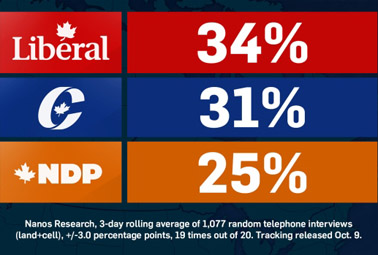
Nanos National Nightly Tracking, Three day rolling average, Oct 6—8, released Oct 9, 2015, 6 AM Eastern.
This remains a theoretical possibility. And if we were working on the Liberal campaign, we’d be aiming in this direction too.
Susanna Kelley at ontarionewswatch.com nicely advanced the general proposition earlier this week, in a piece on “The CPC’s Racism-Based Campaign Has No Place In Canada.”
Ms Kelley alluded to “a backlash against the Conservatives’ appeal to anti-Muslim racism and Islamaphobia.” And then she raised the question : “Wouldn’t it be ironic if the backlash to these CPC tactics helped propel the Liberals – the party whose existence Mr. Harper most detests – Â into a position of power whereby they, alone or along with the New Democrats, ultimately defeated the Conservatives? Â That is looking like a distinct possibility.”
Lorne Bozinoff, president of Forum Research, had something related to say in discussing a recent poll, Â which showed the Liberals at 35%, Conservatives 31%, and 26% for the NDP. These results, Bozinoff urged, “suggest that while Stephen Harper’s support for a niqab ban has traction in Quebec, his position on the issue may be ‘backfiring’ elsewhere in Canada.”
(This Forum poll, btw, also “asked respondents their views on a possible coalition government. Fifty-eight per cent of those polled said they feel two or more parties forming a coalition is appropriate. Fifty-two per cent support the idea of a Liberal-NDP coalition, while 38 per cent said they oppose that scenario, and 9 per cent answered ‘don’t know.’” Â Moreover, just hot off the press : “A Forum Research survey released Sunday [October 11] found support for Justin Trudeau’s Liberals has increased to 37%, while Stephen Harper’s Conservatives are steady at 31%. Less than a quarter of respondents, or 23%, said they preferred the NDP … Translated to seat counts, Forum said the popular support figures mean that the Liberals would score a strong minority of 145 seats, 25 fewer than needed for a majority in the 338-seat House of Commons. The Conservatives would capture 116 seats, with the NDP, who began the campaign in August as front-runners, placing a distant third with 69.”)
Finally, note as well “Trudeau Economic Plan for Canada Trumps Harper’s: Nanos Poll … Â Justin Trudeau is winning the economic argument in Canada’s closely fought federal election … Polling by Nanos Research for Bloomberg shows 39% of Canadians rank Trudeau as the leader with the best economic platform, compared with 33% for Prime Minister Stephen Harper and 16% for New Democratic Party Leader Tom Mulcair.”
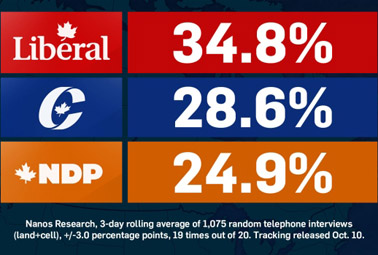
Nanos National Nightly Tracking, Three day rolling average, Oct 7—9, released Oct 10, 2015, 6 AM Eastern.
Now, if 39% (or more) of Canadians were also saying they are going to vote Liberal on October 19, then maybe there would be some prospect of a Liberal majority government. But there is nothing quite like this in any polling data right now (even if the 37% Liberal support in the latest Forum poll could be viewed as moving in the right direction). And, again, there is not all that much time until election day left.
(Though it may be a bit interesting that with only 11 days left in 2011, Nanos Tracking was still not quite picking up the ultimate fact that the New Democrats would finish ahead of the Liberals on election day, Canada-wide! That only happened with 6 days left! Though Forum Research did pick up what Frank Graves finally dubbed the “Orange Crush” as early as 12 days left. So … a Liberal majority still seems a longshot with only 9 days left in 2015 … Â Oh … and Happy Canadian Thanksgiving long weekend too!)
